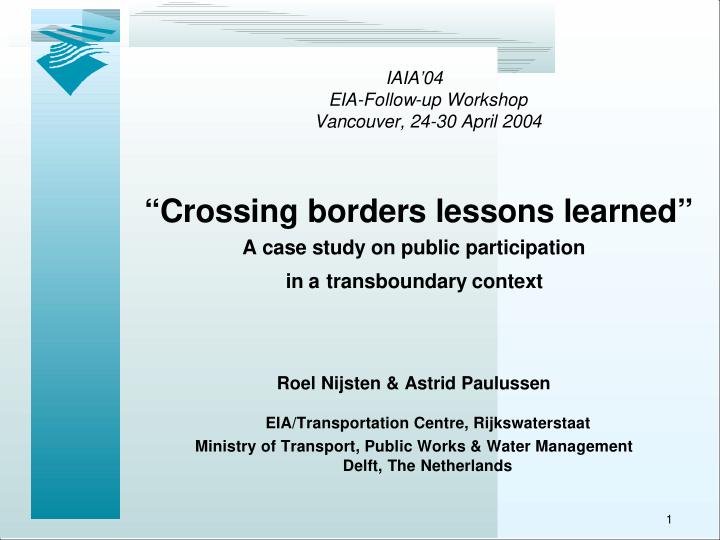



IAIA’04 EIA-Follow-up Workshop Vancouver, 24-30 April 2004 “Crossing borders lessons learned” A case study on public participation in a transboundary context Roel Nijsten & Astrid Paulussen EIA/Transportation Centre, Rijkswaterstaat Ministry of Transport, Public Works & Water Management Delft, The Netherlands 1
The “Space for rivers”-project Watermanagement & flood protection in the Netherlands: “Reaching the borders…….and………crossing them! (1995)” 2
Riverfloodings: causes & solutions Causes (“climatic changes”) • Sealevel-rising (60 centimers) • Increasing riverdischarges (+ 40%) • Subsiding land (60 centimeters) • More rain (10%) Solutions (“space for rivers”) • Relocation of dykes (A) • Lowering floodplains (B) • Removing obstacles in floodplains (C) • Retention areas (D) 3
Transboundary public participation Juridical context • Espoo convention (1991) • EU-Directive 97/11 • Dutch Env. Management Act (1999) • Bilateral agreements (Germany / Belgium) Principles (“Rules of thumbs”) • Non discrimination • Dutch EIA procedure, foreign habits 4
Lessons learned: “Crossing the language border” Lesson 1) Be sure to speak the same language! • translations take time • mistakes in translation can cause misunderstandings and will trouble the public participation process 5
Lessons learned: “Crossing organizational borders” Lesson 2) A clear division of tasks and roles is essential • externally: use the bilateral agreements (“contact points”) • internally: avoid too poor (or too complex!) organization 6
Lessons learned: “Crossing cultural borders” Lesson 3) Be sensitive to the context of your Neighbour(s)! Pay attention to: • differences in EIA “traditions” • intercultural differences • not everybody is familiar with Dutch water policy 7
Lessons learned: “Crossing the EIA procedure borders” Lesson 4) Good explanation of the EIA procedure (and policy context) can help you out Explain: • Dutch EIA procedure • Role of public participation in the Netherlands • The Dutch water policy 8
Crossing borders Conclusion: communication is the key to success • Speak the same language • Agree upon tasks and roles (externally and internally) • Be sensitive to intercultural differences • Explain the Dutch EIA procedure 9
Recommend
More recommend